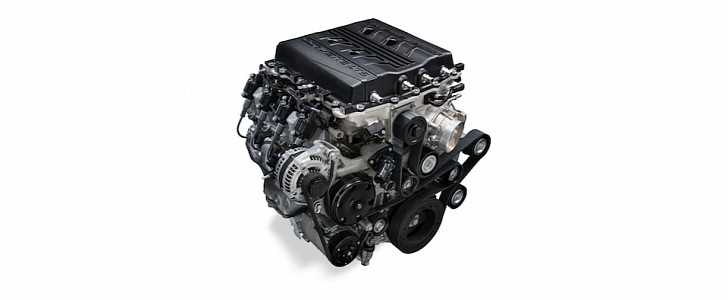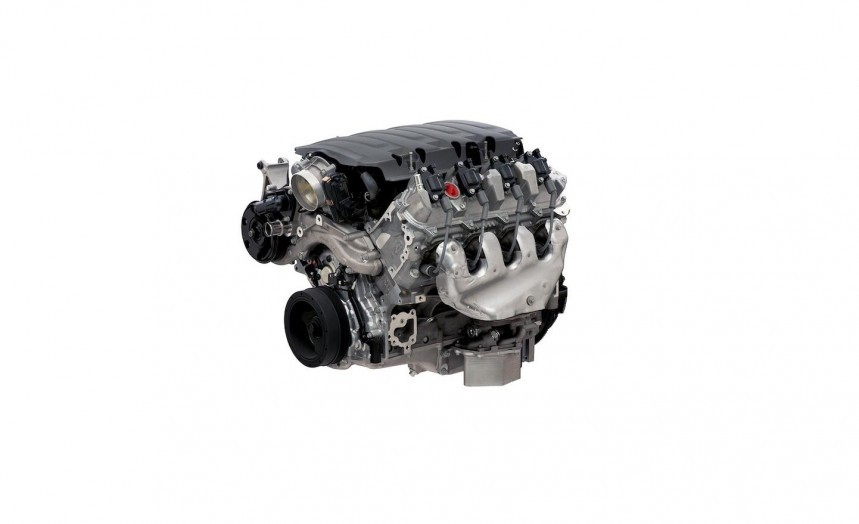Cadillac rolled out the first mass-produced V8, the Ford Motor Company democratized V8s and fueled the hot-rod scene with the Flathead, but Chevrolet takes the crown for the most ubiquitous V8 of them all. The small block entered production in 1954 for the 1955 model year, initially with a displacement of 265 cubic inches or 4.3 liters. Fast forward nearly seven decades, and the small block continues to win the hearts and minds of V8 enthusiasts due to its versatility, simplicity, and interchangeability.
The small block went full Super Saiyan with the third generation, colloquially known as the LS family. A clean-sheet design that shares little with the first- and second-generation small blocks, the LS family was rather controversial when it came out because of its old-school technology. Ford introduced a DOHC version of the Modular engine in the 1993 Lincoln Mark VIII, whereas General Motors preferred pushrods to keep production costs low.
Ed Koerner, the powertrain division’s vice president of engineering operations at the time, is the man who made the LS a reality. The Gen 3 made way for the Gen 4 at the beginning of the 2000s. It differs from the third gen by means of displacement on demand and variable valve timing.
Gen 5 was announced in 2012 with the LT1, which saw its first application in the C7 Corvette. Although it retains the cam-in-block architecture of its predecessor, the current generation uses redesigned heads with different positions for the intake and exhaust valves. The biggest change from Chevrolet’s fourth-generation V8 mills, however, is direct fuel injection.
Presently used in anything from the Camaro to the Escalade, the small block is understandably available in crate-engine format. No fewer than three variants are currently available on Chevrolet.com: LT1, LT4, and LT5.
LT1 is the regular production order code for the naturally-aspirated lump introduced by the C7 in 2014 for the 2015 model year. Similar to the LS3, it features a 103.25-mm bore and a 92-mm stroke. Intended for competition use only, the crate engine develops 460 horsepower at 6,000 revolutions per minute and 465 pound-foot (630 Nm) at 4,600 revolutions per minute.
Architecturally similar to the LS, the first member of the LT family also differs in terms of block casting and oiling system. Available with a traditional wet sump or a dry sump, the crate engine is backed up by a 24-month limited warranty. Identified as part number 19328728, this engine uses a cast-aluminum block with six-bolt nodular iron main bearing caps.
A billet steel roller camshaft, a forged steel crankshaft, forged powdered metal connecting rods, hypereutectic aluminum pistons, and a 58X reluctor wheel also need to be mentioned. GM recommends premium pump gas for the LT1 crate engine. Also worthy of note, don’t take it above 6,600 rpm.
LT4 is what the biggest of the Big Three in Detroit calls the supercharged sibling of the LT1. Building on the LS9 of the C6 ZR1, the LT4 was introduced in 2014 for the 2015 model year by the C7 Z06. Not long after, it was employed in the Cadillac CTS-V, Chevrolet Camaro ZL1, and the more recent Cadillac CT5-V Blackwing and Escalade-V. With the exception of the 2.7-liter blower of the Escalade-V, all LT4s – including the crate engine – employ a 1.7-liter supercharger from the long-running Eaton TVS series.
Available exclusively with a wet sump, the LT4 crate engine can be purchased together with the 8L90-E eight-speed automatic transmission. The torque-converter automatic is also available with the LT1 crate engine. Good for 640 horsepower at 6,400 revolutions per minute and 630 pound-foot (854 Nm) at 3,600 revolutions per minute, the force-fed V8 can handle just over nine pounds per square inch of boost from the Roots-type blower.
To facilitate the Eaton R1740 TVS supercharger, General Motors dropped the compression ratio from 11.5:1 in the LT1 to 10:1 in the LT4. The largest automaker in the U.S. of A. uses Rotocast A356-T6 aluminum heads instead of the LT1’s 319-T7 cast-aluminum heads. Alternatively known as centrifugal casting, rotocasting is a manufacturing process that involves rotating the cylinder head’s mold during casting to eliminate porosity.
Finally, LT5 is the ultimate incarnation of the small block in both production vehicles and as a crate engine. Introduced by the supercar-slaying C7 ZR1, the LT5 produces 755 horsepower at 6,400 revolutions per minute and 715 pound-foot (969 Nm) at 5,000 revolutions per minute. The primary difference between it and the LT4 is the supercharger, which is 64 percent larger at 2.65 liters. It also flaunts more boost, namely 14 pounds max.
Gifted with the same 10:1 compression ratio as the LT4, the LT5 crate engine uses titanium intake valves and sodium-filled exhaust valves. The 95-millimeter throttle body also happens to be slightly larger than the 87-millimeter unit of the LT4. Last, but certainly not least, the LT5 combines the direct fuel injection of the LT family with good ol’ port fuel injection.
Ed Koerner, the powertrain division’s vice president of engineering operations at the time, is the man who made the LS a reality. The Gen 3 made way for the Gen 4 at the beginning of the 2000s. It differs from the third gen by means of displacement on demand and variable valve timing.
Gen 5 was announced in 2012 with the LT1, which saw its first application in the C7 Corvette. Although it retains the cam-in-block architecture of its predecessor, the current generation uses redesigned heads with different positions for the intake and exhaust valves. The biggest change from Chevrolet’s fourth-generation V8 mills, however, is direct fuel injection.
Presently used in anything from the Camaro to the Escalade, the small block is understandably available in crate-engine format. No fewer than three variants are currently available on Chevrolet.com: LT1, LT4, and LT5.
Architecturally similar to the LS, the first member of the LT family also differs in terms of block casting and oiling system. Available with a traditional wet sump or a dry sump, the crate engine is backed up by a 24-month limited warranty. Identified as part number 19328728, this engine uses a cast-aluminum block with six-bolt nodular iron main bearing caps.
A billet steel roller camshaft, a forged steel crankshaft, forged powdered metal connecting rods, hypereutectic aluminum pistons, and a 58X reluctor wheel also need to be mentioned. GM recommends premium pump gas for the LT1 crate engine. Also worthy of note, don’t take it above 6,600 rpm.
LT4 is what the biggest of the Big Three in Detroit calls the supercharged sibling of the LT1. Building on the LS9 of the C6 ZR1, the LT4 was introduced in 2014 for the 2015 model year by the C7 Z06. Not long after, it was employed in the Cadillac CTS-V, Chevrolet Camaro ZL1, and the more recent Cadillac CT5-V Blackwing and Escalade-V. With the exception of the 2.7-liter blower of the Escalade-V, all LT4s – including the crate engine – employ a 1.7-liter supercharger from the long-running Eaton TVS series.
To facilitate the Eaton R1740 TVS supercharger, General Motors dropped the compression ratio from 11.5:1 in the LT1 to 10:1 in the LT4. The largest automaker in the U.S. of A. uses Rotocast A356-T6 aluminum heads instead of the LT1’s 319-T7 cast-aluminum heads. Alternatively known as centrifugal casting, rotocasting is a manufacturing process that involves rotating the cylinder head’s mold during casting to eliminate porosity.
Finally, LT5 is the ultimate incarnation of the small block in both production vehicles and as a crate engine. Introduced by the supercar-slaying C7 ZR1, the LT5 produces 755 horsepower at 6,400 revolutions per minute and 715 pound-foot (969 Nm) at 5,000 revolutions per minute. The primary difference between it and the LT4 is the supercharger, which is 64 percent larger at 2.65 liters. It also flaunts more boost, namely 14 pounds max.
Gifted with the same 10:1 compression ratio as the LT4, the LT5 crate engine uses titanium intake valves and sodium-filled exhaust valves. The 95-millimeter throttle body also happens to be slightly larger than the 87-millimeter unit of the LT4. Last, but certainly not least, the LT5 combines the direct fuel injection of the LT family with good ol’ port fuel injection.










